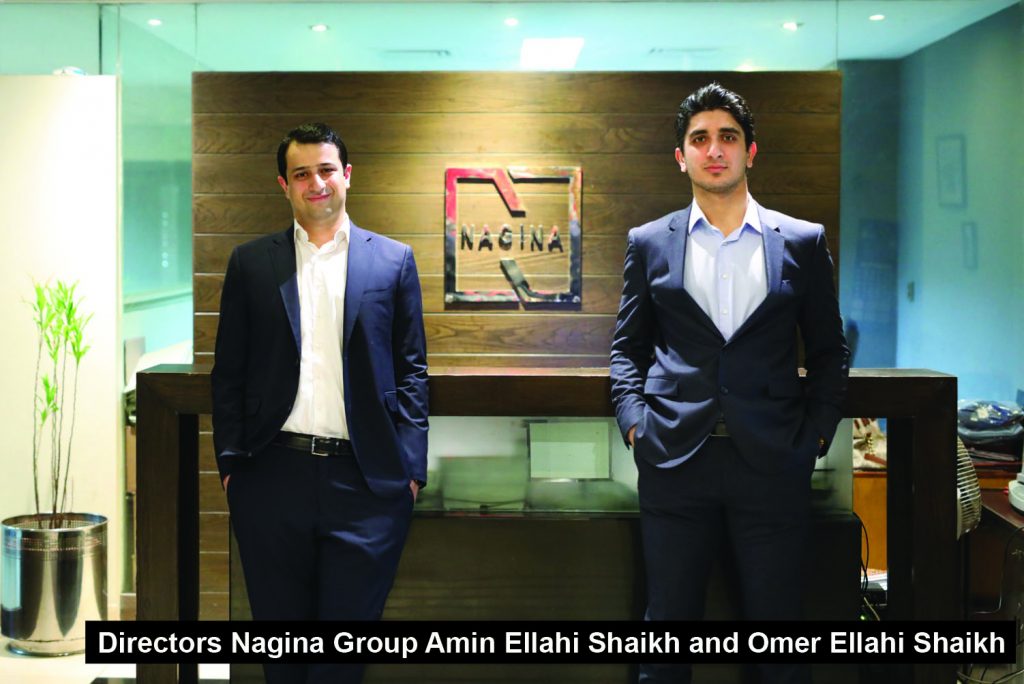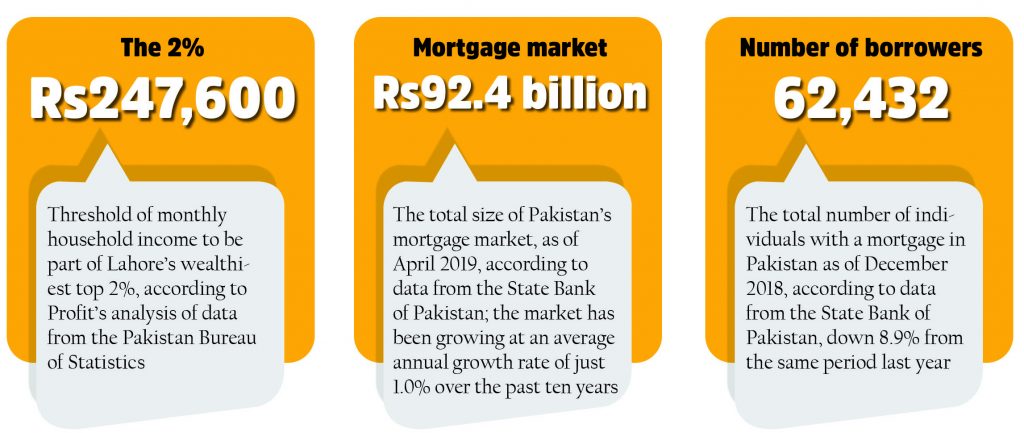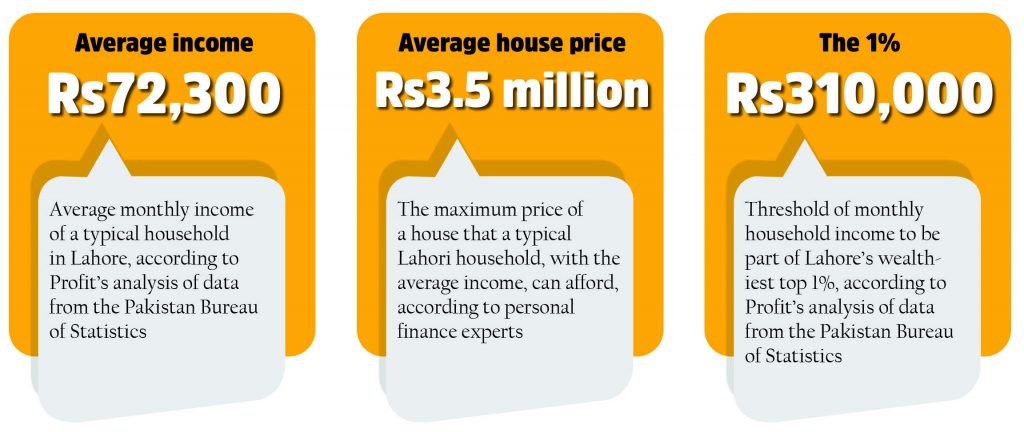Karachi is still the largest city in Pakistan, but by some measures, the greater Lahore metropolitan area may now be almost equal in size, if not already somewhat larger. Yet for most of its history, Lahore’s residents have shunned the notion of vertical expansion of their city’s size, which is why it is difficult to find apartments in the city.
In recent years, however, there has been a move towards changing that, with several real estate developers investing in building up apartment blocks in the city. And indeed, some of them have gotten to become quite high end: it is now possible to buy a $1 million apartment in Lahore, at least insofar as listed prices on Zameen.com are concerned.
One set of developers who are trying to profit from this growing trend are the Nagina Group, a textile conglomerate that owns three publicly listed companies: Nagina Cotton Mills, Ellcot Spinning Mills, and Prosperity Weaving Mills. The group now intends to diversify into real estate.
“Nagina Group has been in the textile business in Pakistan for a long time – since 1967, in fact,” explains Amin Ellahi, Sheikh, one of the directors of the group. “Our first spinning mill in Pakistan was set up in Kotri, Sindh and is still the bedrock of our business. Since then, we expanded into Punjab, setting up another spinning unit and also diversifying into the weaving sector in the late 1990s and early 2000s”.
“A decade later – and with the younger generation of Nagina Group joining management – we pondered the age-old question: do we expand our existing textile footprint or diversify into a new venture? After some deliberation, it became increasingly clear to us that while latent demand existed, Lahore was lacking genuine high-end residential spaces. Sensing that this was a field that we could add value in, we decided to develop boutique luxury apartments in Gulberg.”
The group’s first foray into the space is a luxury apartment block in the heart of Gulberg, a neighbourhood that still defines Lahore’s upper-middle-class chic.
However, the apartment real estate market in Lahore is not without its challenges, and Nagina – as well as the other investors operating in this market – have had to innovate in order to overcome them.
Lahore’s aversion to apartments
The citizens of Lahore have a famed aversion to apartment living. This is often chalked up to a “Punjabi mindset”, though considering the number of Punjabis who own apartments in Karachi, Dubai, and other parts of the world, this is perhaps mistaken. Nonetheless, there is truth in the fact that owning the land one lives on is something culturally important to people in Lahore, and one that apartment ownership does not appear to offer.
Sheikh, however, has a somewhat simpler explanation: the reason why Lahoris have not historically taken to vertical living is because – until now – they have not needed to.
“Some people argue that apartments as an idea are a tough sell in Lahore due to the “Punjabi mentality” and the need to own land. We feel differently. Lahoris have already started appreciating apartment life and it is a matter of if – not when – the larger market recognizes the value as well,” he said, in an interview with Profit.

And now that the need has arisen, he believes they will adapt, just as the residents of Karachi did in an earlier era, even though the cities have otherwise different characteristics.
“Karachi and Lahore are totally different and very interesting markets. First of all, Karachi is a port city and port cities around the world have unique characteristics compared to interior cities. These cities naturally attract both commerce and travel. Karachi’s population is over 16 million people – almost 50% larger than Lahore’s. Most importantly, Karachi’s avenues for expansion are geographically limited,” he said.
“[Karachi’s] DHA Phase 8 has reached the geographical limit of Karachi being surrounded by water on three sides. Without land to expand, Karachi’s only option is to expand north or to develop vertically. In the north, Bahria Town is a prominent new development and DHA City is also coming up. But those are at significantly long distances from the center of Karachi. So I think, by necessity, Karachi had to accept the concept of vertical development faster than Lahore.” he explained.
As for Lahore, it now appears to be encountering similar limitations to its horizontal expansion. “Lahore has a physical barrier as well: the northeastern border with India. Thus, the logical places for societies (DHA excluded) has been towards Raiwind and Multan Road in the south, but those developments are becoming extremely saturated and difficult to access. So, Lahore is slowly arriving at Karachi’s cultural acceptance of apartment style living — it will just take a little longer.”
Housing affordability and financing
The biggest problem for a real estate developer focused on residential real estate is the simple fact that housing is unaffordable relative to incomes.
According to Profit’s analysis of data from the Pakistan Bureau of Statistics, the average household in Lahore makes Rs72,300 per month. Personal finance experts believe that an affordable house is four times the annual income of a household, which means that the average Lahori family can afford a home worth just under Rs3.5 million.
So how much house can a typical Lahori family afford?

According to the real estate price index maintained by Zameen.com, as of April 2019, the average price of a house in Lahore is Rs10,401 per square foot. That implies that a small, 125-square-yard (or 5-marlas, as would be common parlance in Lahore), house would cost Rs11.7 million (or Rs1.1 crore, for those of you more comfortable with the vernacular terminology of large numbers). Of course, such a house is quite out of the price range we quoted above for the typical Lahori family.
Even the top 1% of Lahori households would struggle to buy a home in the city. According to Profit’s analysis of data from the Pakistan Bureau of Statistics, the top 1% of households in Lahore had an income of Rs310,000 per month, which implies that they can afford a home worth Rs14.9 million. To be in the top 2% of households in Lahore, one needs to have an income of Rs247,600 per month, and those households can afford a home worth Rs11.9 million.
In other words, that typical 125-square-yard home in Lahore? Only 2% of Lahori families can afford one.
And that “four times your annual income” number assumes the availability of housing finance, which is far from guaranteed in Pakistan, which has among the worst rates of mortgage finance availability in the world, including among South Asian countries.
As of April 2019, Pakistan’s entire mortgage market was worth a paltry Rs92.4 billion, according to data from the State Bank of Pakistan, and grew by an average annual rate of just 1.0% per year over the past 10 years. The total number of mortgage borrowers in Pakistan was 62,432, as of the end of December 2018, which is actually down by 8.9% over the previous year, and is significantly below the peak of over 150,000 mortgages reached in mid-2005.
“This is a large gap in this industry in Pakistan. Nowhere in the world are people expected to finance their housing needs completely independently,” said Amin. “Financial institutions exist that assist them in bridging the gap. Banks here have a very low risk profile, and as a result the risk level that real estate customers are forced to accept is very high.”
“They must give large down payments and pay installments on the hope that the developer is reliable and will complete the project on time and as promised. Sometimes it works out well for the real estate investor, but other times it does not. I hope this new government is able to provide better housing solutions for Pakistani’s because we direly need it. A big part of that solution must focus on a better mortgage finance system.”

For their part, the Nagina Group believe that prices are likely to keep rising because costs have risen substantially over the past two years owing to the rapid depreciation of the rupee against the US dollar.
“We started this project about three years ago. Since then, the cost of inputs like cement, steel, sand, and crush have all been rising steadily,” said Amin Ellahi. “And this makes sense. If coal is a significant input cost for cement, and coal has to be imported in US dollars, then the rupee prices of inputs will obviously rise as well if the rupee depreciates. As this happens, the cost of manufacturing cement rises and the manufacturer will pass on this cost increase to the consumer. Going forward, it seems like the pressure on the rupee could continue. So, we feel that while raw land may not be significantly overvalued in rupee terms, developed real estate may be undervalued and definitely has a good chance of appreciating quite significantly in rupee terms.”
And the lack of financing is an issue not just for buyers, but also for developers, who cannot borrow for the cost of construction, which results in a peculiar mode of financing called “market financing”.
“To put it simply, if you have the money to build and complete the project yourself, it is equity financed. If you require advances and installments to complete construction, it is a market financed project,” said Amin. “When prices rise and projects are well sold, the intrinsic risk of market financed projects slips under the radar. But if real estate prices drop and pace of installments slow down, construction work can stall and projects remain incomplete for long periods of time.”
This, in turn, creates problems and a general lack of trust in Pakistan’s real estate market by ordinary consumers who do not know if they can rely on the developer to keep their word in constructing and delivering projects on time.
“In Pakistan, sometimes developers focus on the marketing of a project more than its completion,” said Amin. “In fact, some units are sold based on just a brochure and a promise.”
Nagina tried to approach the matter differently. “In our case, we chose to take the burden of development risk away from our customer by not selling any apartments until the building structure was already complete and finishing was underway. We wanted the majority of the development approvals from the relevant authorities in hand and we wanted the apartments to be close to their final shape before opening sale. Just like the decision to make only three-beds, this lowers the IRR [internal rate of return] for the developer, but gives the customer a more straightforward product and a realistic timeline.”
Nagina’s target market
The apartments at 19Q (so-named because of the address of the building: 19Q Gulberg 2) have been priced at Rs55 million each. Given the fact that fewer than 2% of Lahore’s population can afford their product, the Nagina Group have given considerable thought to the kind of clientele they are seeking to attract, focusing on families who will make their first development their primary residence rather than people who may purchase the property as a pied-a-terre.
“Our target customer is sophisticated, family oriented, financially stable, and aligned with the values of the building,” said Amin. “A year before breaking ground, we sent out a detailed questionnaire to prospective customers to help understand their requirements carefully. Amongst many insightful responses, one thing became clear: while people were ready to accept the concept of apartment living, they felt apprehensive about neighbour risk. Who would they live next to? Would their neighboring apartment be the home of a family-oriented banker or would it be a weekend getaway for an out-of-towner?”
That, in turn, meant making decisions which would impact not just how fast the apartments would sell, but also the returns that the developers could expect on the project.
“Of course, all project developers will tell you that they interview and vet residents, but we decided to go a step further and designed the project in a way that this issue is minimized to begin with. We decided to remove one- and two-bedroom apartments from the configurations entirely,” said Amin.

“This was a unique approach, because the one- and two-bedrooms are actually the easiest to sell and most profitable for developers. Their lower prices attract all sorts of buyers and help with early deposits. The three-bedroom apartments take longer to sell but the buyers of three bedrooms are more likely to be families and working professionals. So, we think that good planning and design can be just as important as spending money upfront when it comes to creating the right living space.”
The benefits of density
Ultimately, however, what the Nagina Group is really betting on is that the benefits of density – both in the form of affordable housing in prime locations and the economies of scale that come with an apartment building – will be attractive to homeowners in Lahore.
“An increase in population density helps nearby ancillary businesses greatly,” said Amin. “A family of 5 previously resided in this approximately 12,000 sqft. of covered area. We expect almost 100 residents to live on the same footprint of land but with over 90,000 sqft. of developed space. Even just a handful buildings such as these amplifies this concept greatly and nearby businesses benefit. The hair salons overflow with ladies, the restaurants gain a hustle and bustle, and the cinemas become packed.”
And then there is the affordability.
“A similarly priced house can be a huge headache to first acquire the land for, then build a house on and lastly maintain. So, the first convenience comes in the ease of acquisition vs buying land and/or building your own house. Maintenance and the cost of that maintenance would be the second most important one,” said Amin.
“A house requires multiple security guards to protect, a large number of staff to clean, and generators which require both fuel and maintenance. If you have a swimming pool, you need a separate person for that. If you have a small gym at home, that equipment needs routine maintenance as well. Managing all this can be a nightmare, and the costs for a single household can snowball relatively quickly. In an apartment building, the management of all this is handled by a building management team.”
“Moreover, the economies of scale are shared between the residents. Instead of 3-4 guards for every household, there could be 8-10 guards for 25 households. Lastly, the convenience of location cannot be beaten. Most offices, banks, and the best restaurants are still in Gulberg- the heart of Lahore. 19Q is situated in a secluded residential neighborhood, right off of M.M Alam Extension. The convenience of this location is just unbeatable.”
Conflicting opinion on apartments
Attitudes among Lahore’s homeowners certainly do appear to be changing, at least a little bit. Fatima Bukhari, a Lahore-based psychiatrist and homeowner, can see the value in apartments.
“Living in Lahore’s Johar Town area security issues have become a nuisance. Our place has been targeted by robbers twice in the last few years. I feel apartments are much more secure in the sense that they are seldom targeted by robbers,” she said.
There does appear to be a consensus that apartments are generally safer than houses. “Apartments are safer when it comes to robbery. People don’t tend to rob apartments. Houses are more prone to theft,” said Asad Ehsan, a UAE-based banker with family in Lahore.
However, both Fatima and Asad have a preference towards houses. Fatima explains: “In apartments there is a lack of privacy since most of them are built right next to each other which poses another kind of security concern if the neighbours are not like minded. Moreover, with apartments there is this prevailing concept that they lose their resale value after a period of around 20-30 years, once the building gets old, so in that sense they might be a risky investment.”
Asad Ehsan feels much the same way. “In a house you have a lawn you can sit outside. There is more sunlight. In an apartment you cannot sit outside. In a house you don’t need a lift. You enter your house and that is pretty much it. In apartments, especially in a city like Lahore, where electricity is a problem and you are living on the sixth floor, so that can be a problem, where you might have to climb the stairs.”




















A very well prepared article.
Lahoris wont go for apartments till we have land upto qasoor on one side.. Upto bhai bheru on other side etc
.. Lahoris dont have problem of land yet and and will prefer even 5 M home on expensice otlr cheaper place over an apartment. Acres and acres of housing societies are still empty… It wll take at least a decade to be able to start taking apartment seriously by lahories.
Very informative
U guys have missed the core issue. KARCHI HAS SEA breeze 10 months of the year. While lahore has no Air movement for 11.5 months of the year. It is impossible to live in an appartment bldg in lahore unless it is centrally aircondintioned and u can afford to pay the bills. Karachi has no issue of Air movement and in load shedding it is easily posibble to stay in the appartment with windows ooen.
Well said.
The guys are with no innovative solution. Housing at affordable prices has been and will remain an issue in Lahore. 5.5 million worth flat if innovative slotion, then i must say “hats off to your strategists”..!!!!.
I think price of an apartment is quoted to be 55 million instead of 5.5 million.
Well I think there is a problem with trust. Can you trust a real estate developer to adhere to all the necessary legal codes? We in Lahore saw a few years ago when many high rises did not and they had their tops of buildings shaved off by the Punjab government. With an apartment owner what happens if some thing like that happens with the apartment you just bought?
55 Million. Not 5.5 million. God knows who can afford. And Lahore is too hot for apartment living unless it’s fully air conditioned, which is expensive to maintain.
the land conversion from agri to industrial, commercial and residential may be banned and existing space must be used for future vertically or horizontally. Heave taxes may be imposed on size of the residential and commercial plots. Even industries should be in multiple story buildings where possible such tailoring etc.
Very informative, it can work if properly communicate to the society regarding safety and comfortable living.
First point about price if Nagina Group apartments that it is too expensive as a 20 Marla(1 kanal) house can be purchased in DHA or Bahria. So why to confine in vertical ladder.
Second point is related to our lack and disregard for good planning. Why everyone wants to live in Lahore and then up to what distance is Lahore from Anar Kali or Laxami? Those who have reached Raiwind or Kahna , also think they are in Lahore. Setting of new planned cities at well decided distances and good natural habitats is most desired, health wise excellent, socially important and administratively correct approach.
But who cares. What is wrong if new city e.g. named A if established with 10 km clear patch of agriculture belt from main Lahore City would have been best. So choice of apartments is like increasing exponentially the load of consumers on the same dining table of Lahore. It will carry mega issues of all kinds. Rest the business conglomerate will value his earnings more that focusing him on the value for customer cliches of modern marketing gurus. May Allah the Almighty bless our country and guide and unite us on things which are good for us. Aameen
The only advantage in these type of projects is completion in shortest time.
The group management have the ability to get it thru.Now with Chinese around would be more fruitful.Best of luck
Lahore should have to be prepared for Apartment Life long time before as LDA, DHA, Bahria Town, Paragon City & many numbers of socities have already deprived Pakistan of Agricultural Lands thats a big loss to our Economy.
It’s Asghar Khurshid from Lahore college road is it possible I offer my self in front marketing staff in any project in Lahore
Nobody is Talking on ROI and Value appreciation which will be not fruitful for this high price. I would prefer buying an apartment in DUBAI with 8% per annum ROI. That would that 12-14 years to me back my investment and later I can just enjoy its value and rental income.
We need affordable housing first in Lahore then Apartment Complex can be a boom.
A huge apartment complex just propped up right next to our house in gulberg. The owners were no where to be found. Labourers three stones in our lawn and made loud noises even at night. Our peace of mind was greatly disturbed. To top it all we couldn’t sit out as the nasty labourers were staring at us. It was a complete invasion of our privacy. This is right next to our residence in block C Gulberg 2 lahore. Horrible people who have decided to make buildings in peaceful neighbourhoods.
A whole article has been published without some basic research? or should I say it was purposely done due to marketing pressure?
Have you considered the average prices of plots in Lahore as compared to Karachi? In DHA Karachi, a 500 yard plot cost is above 7 crores. You cannot find a single plot below that price. And even the area which is undeveloped in Phase 8, which will not be given possession in 5 years time even, the prices for that too are above 6 crores.
And what about Lahore? DHA phase 7, which has been given possession, the prices of 1 Kanal plots are below 2 crores. Even the highly esteemed DHA phase 8 whose possession was given last year, the prices of plots in some blocks like S and X are well below 2 crores. And in the highly marketed phase 9, which is being developed currently, the prices of 1 Kanal plots are just around 1 crores 10 lacs. And this is DHA we are talking about, there are tons of societies in Lahore, all great for living with all amenities, such as SNGPL, state life near DHA, and on raiwand side Wapda town, lake city, bahria town, etc you can easily get so many options all in very reasonable prices.
So with that huge price difference, it makes perfect sense for Karachiites to live in apartments, that are in terrible shape, with no amenities and lots of issues, and yet paying few crores for a decent size 3 bed apartment. They have no other options in that price range. But why would Lahoris buy expensive apartments when there are thousand of good schemes offering plots at reasonable rates?
Keep in mind that as opposed to plots, apartments prices can’t be kept cheaper as there is a high cost of construction one has to pay regardless of the city. So it would make no sense for Lahoris to purposely opt for apartments when they can get so many options to own their own house. All around the world, the apartment model works in those places where the property is extremely expensive and hence it makes sense to grow vertically. Lahore property dynamics are such that the property prices will not increase much in even next 10 years due to huge supply glut.
Why waste so much money on a prospect where “na zameen apni, na aasmaan apna”.
maybe after 20years time this strategy brings fruit to thier thinking like double razor shaving blade took more than 20 years to replace usatra local blade and thanks to hapatitis all this is marketing gimmick at this stage spending 55million is stupidity think many times even if you have illegal money
Comments are closed.